
By SECRETARY OF FINANCE BENJAMIN E. DIOKNO
The Philippines performed well in a very challenging 2023 and will do even better in 2024
The Philippine economy has performed well despite a challenging economic and financial environment in 2023 beset by ongoing geopolitical tensions, imposition of trade restrictions, and extreme weather events resulting in high domestic commodity prices, especially for rice and fuel. At the same time, we are forging for an even better outlook for 2024. This is enabled by the reconstitution of the Economic Development Group (EDG) and the creation of the Inter-Agency Committee on Inflation and Market Outlook (IAC-IMO), along with the implementation of coherent macroeconomic policies, particularly with the establishment of the Medium-Term Fiscal Framework (MTFF), and the ongoing implementation of game-changing structural reforms.
Most multilateral organizations share this optimism as they expect the Philippines to be one of the fastest growing economies among the major economies in Asia in 2023 and 2024 even with recent revisions in economic projections (Figures 1 and 2).
The International Monetary Fund (IMF) sees that the Philippine economy will have the strongest growth relative to ASEAN-4[1] and Vietnam, supported by an acceleration in public investment and improved external demand for the Philippines’ exports, after the country has withstood a confluence of shocks through its appropriate policy response and recent implementation of key structural reforms to stimulate exports, spur foreign investment, and raise growth potential. The World Bank agrees that the country’s economy will accelerate in 2024 driven by private consumption. It projects the Philippines to be the fastest-growing economy among Asian countries in the East Asia and Pacific region in 2023, and the second-fastest in 2024.
Credit rating agencies and market analysts also express confidence in the country’s macroeconomic fundamentals, as shown by the country’s maintained investor-grade credit ratings amid a sea of downgrades in other economies, including the US. In particular, the S&P’s stable outlook for the country reflects its “expectation that the Philippine economy will maintain healthy growth rates and the fiscal performance will materially improve over the next 24 months.” The Fitch Ratings forecasts that the country’s “growth over the medium term will be considerably stronger than the median of similarly-rated peers supported by large investments in infrastructure and reforms to foster trade and investment, including through public private partnerships (PPP).” Moody’s also deems that the country will have a “rapid economic growth relative to peers, complemented by the stabilization and eventual reversal of the deterioration in fiscal and debt metrics.”
[1] Excluding Singapore and advanced economies.
Figure 1. Multilateral Organizations’ GDP growth Outlook for Selected ASEAN Countries in 2023
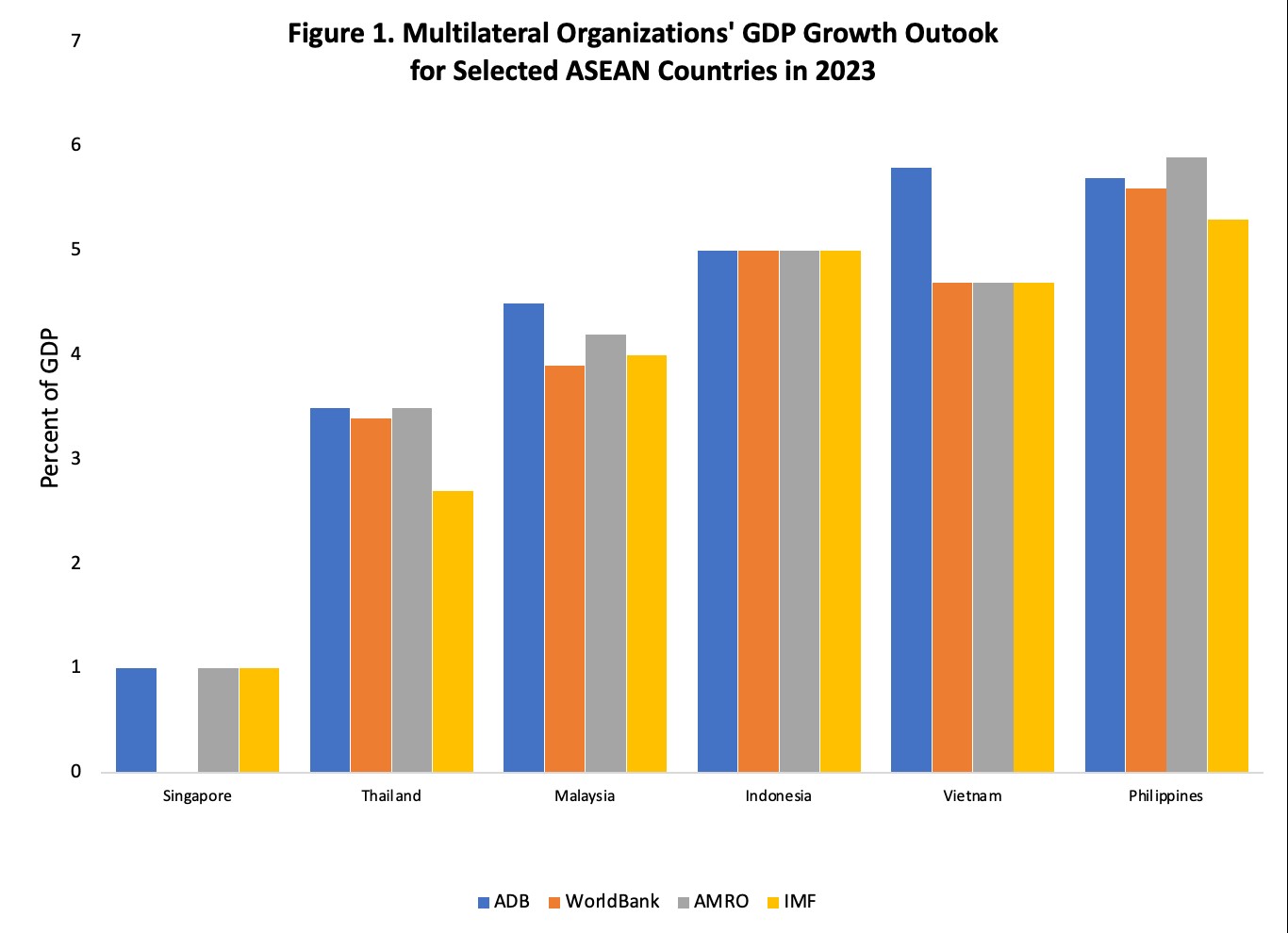
Data sources: ADB, World Bank, AMRO, and IMF
Note: World Bank has no available economic outlook estimate for Singapore
Figure 2. Multilateral Organizations’ GDP growth Outlook for Selected ASEAN Countries in 2024
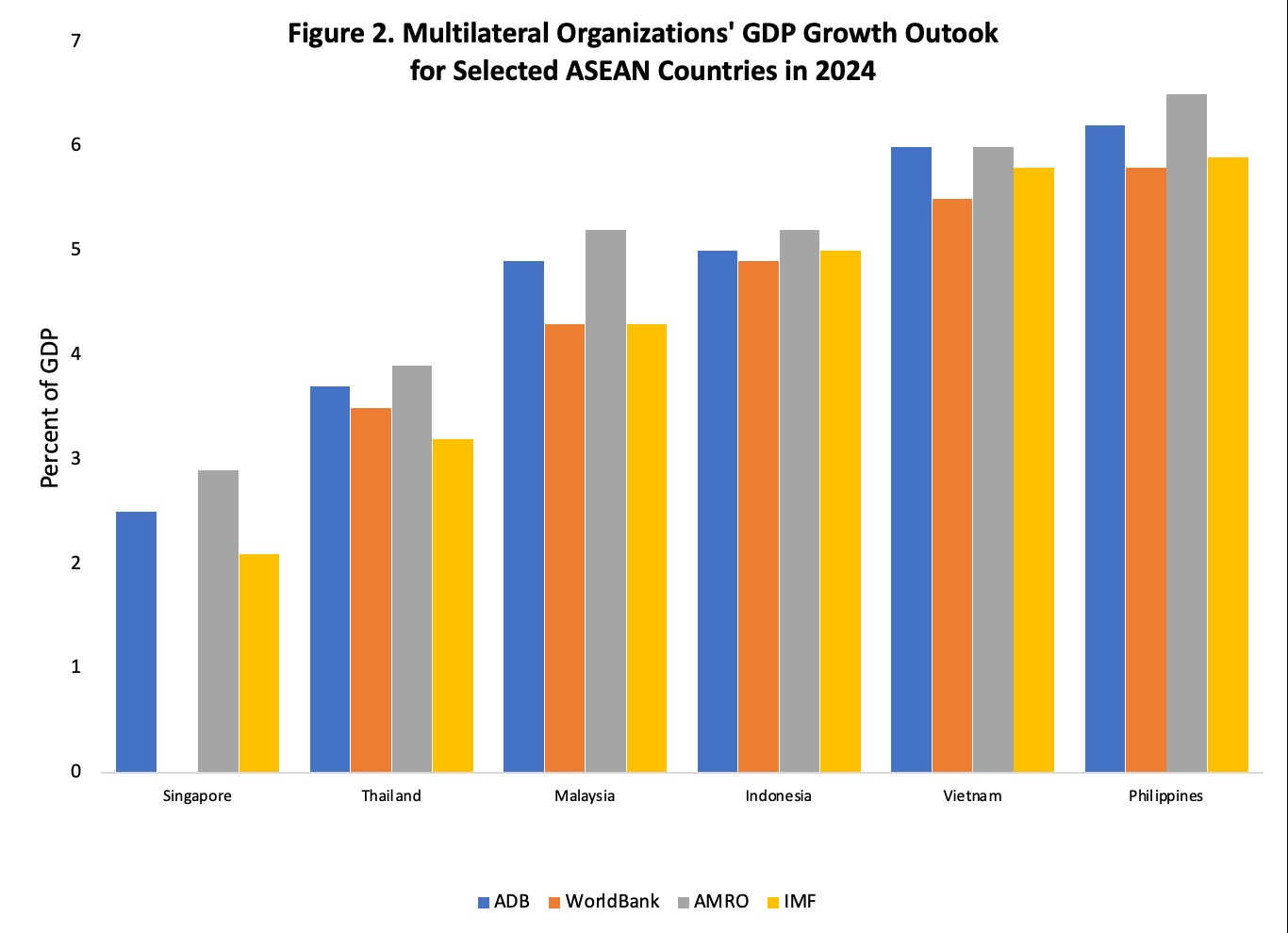
Data sources: ADB, World Bank, AMRO, and IMF
Note: World Bank has no available economic outlook estimate for Singapore
The Philippine economy will remain robust. The Philippine economy will likely grow close to the low end of the 6.0 to 7.0 percent growth target for 2023, despite a difficult global environment and existing domestic challenges. Economic growth will continue to be broad-based, led by the services and industry sectors. It will be continually buoyed by robust domestic demand, supported by the further easing of inflation, lowest unemployment rate, and strong inflows of remittances from overseas Filipinos (OF). The acceleration in government spending will also push growth as we expedite the implementation of catch-up plans, programs, and projects, particularly on infrastructure, as prioritized in the EDG discussions.
Inflation is on the mend. The inflation has been decelerating despite price pressure being a global issue in 2023. This proves the effectiveness of aligned monetary and fiscal policies as well as the efficacy of direct measures to augment domestic supply, address logistical bottlenecks, and arrest uncompetitive practices in key commodity markets.
Inflation continued to slow down, settling at 3.9percent in December 2023, down from 4.1 percent in the previous month and from the 8.1 percent inflation a year ago (Figure 3). The decrease in overall inflation in December 2023 can be primarily attributed to lower year-on-year inflation rates in key sectors, specifically housing, water, electricity, gas, and other fuels as well as food and non-alcoholic beverages.
For the full year, inflation averaged at 6.0 percent, aligned with the revised 6.0 percent inflation assumption of the Development Budget Coordination Committee (DBCC) for 2023. However, this is higher than the 2-4 percent inflation target of the government and the 2022 inflation rate of 5.8 percent.
The government’s direct measures to mitigate the impact of lingering supply-side factors on inflation as well as its commitment to a fiscal consolidation path through the MTFF allows fiscal policy to be consistent with the monetary policy tightening of the Bangko Sentral ng Pilipinas (BSP) to mitigate inflationary pressures. These help in reducing inflation to within the BSP target range of 2-4 percent in the first quarter of 2024, averaging at 3.7 percent for full year 2024 and at 3.2 percent in 2025. This progress is expected to yield positive influence on consumer spending and investments in the coming year and beyond.
Figure 3. Headline Inflation and the Contributors to Inflation
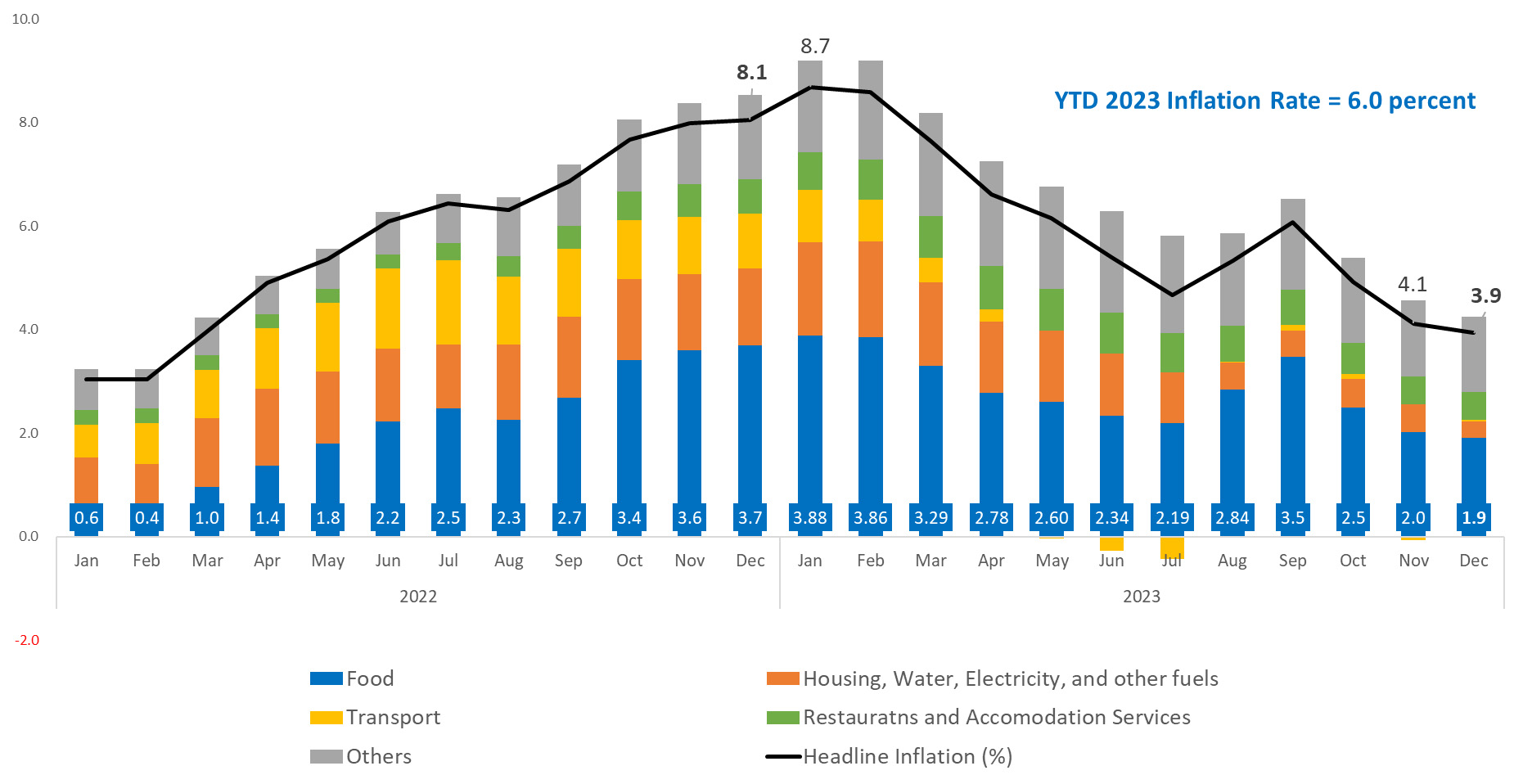
Data Source: Philippine Statistics Authority (PSA)
The jobs market looks bright. The steady and low unemployment and underemployment rates underscore the continued economic momentum in our country.
In October 2023, the country recorded the lowest unemployment rate since April 2005 at 4.2 percent, same as the one recorded in November 2002 (Figure 4).
The quality of employment also continually improved as the underemployment rate was at 11.7 percent, lower than 14.2 percent a year ago, albeit higher than 10.7 percent in the previous month. Moreover, improvement in the quality of jobs is evidenced by longer average hours of work, greater number of wage and salary workers that have a more remunerative class of work, and less unpaid family workers.
These developments show the successful initiatives of the government aimed at enhancing employment opportunities and labor conditions that resulted in a robust labor force participation. The sustained improvement of the labor market environment, coupled with the declining inflation rate, remains as a strong driving force towards the country’s economic growth.
Figure 4. Unemployment and Underemployment Rates

Data Source: PSA
The manufacturing sector continues to support growth. Various data on the Purchasing Managers’ Index (PMI) for the Philippines generally recorded above the 50 threshold in the first 11 months of 2023, indicating a continued expansion in the sector. The S&P Global (Figure 5) posted a PMI of 52.7 for the Philippines in November 2023 while the Philippine Institute for Supply Management[1] reported a PMI of 54.8 in October 2023, suggesting continued manufacturing growth in the last quarter of the year.
Aside from PMI, the expansion of the manufacturing sector is also reflected in the growth in car sales at 7.1 percent year-on-year growth over the 11-month period.
[1] Based on Philippines’ PMI tables posted on the BSP website.
Figure 5. Purchasing Managers’ Index (PMI)
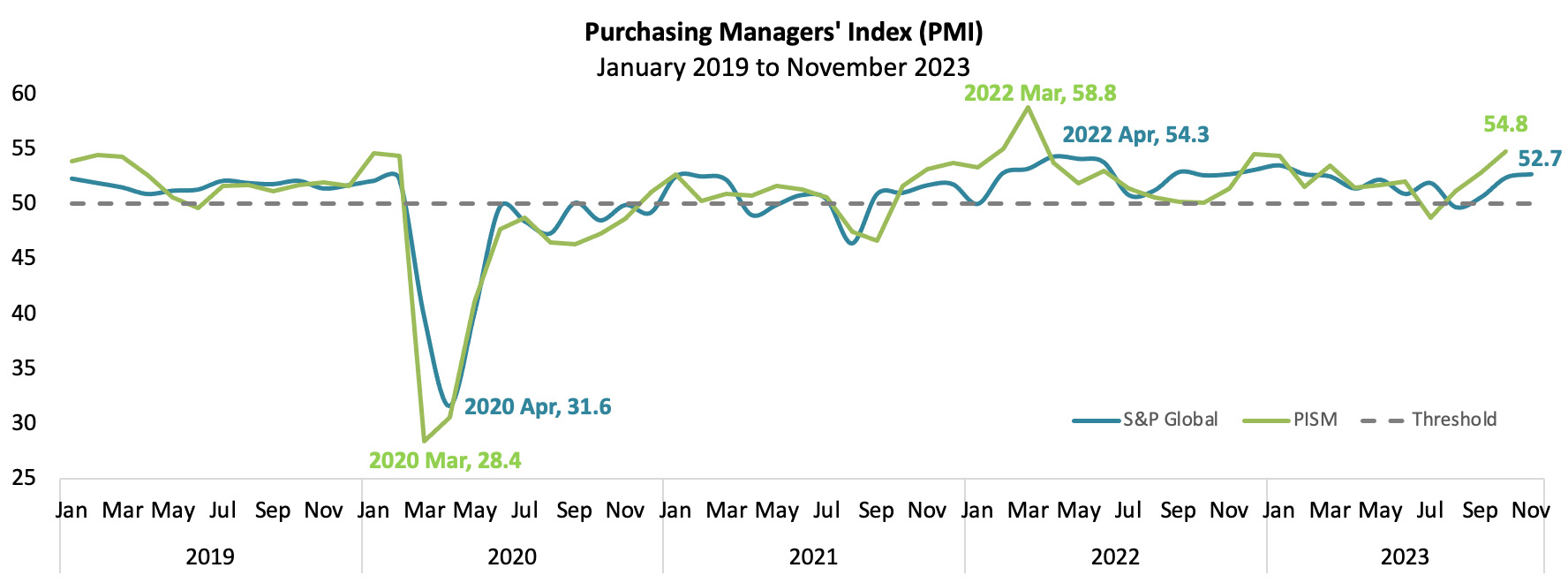
Data Sources: S&P and BSP
Fiscal policy is sound. The 2023 fiscal numbers – the National Government (NG) debt-to-GDP and deficit-to-GDP ratios – are within the parameters of the Medium-Term Fiscal Framework (MTFF).
In the first three quarters of 2023, the NG deficit-to-GDP ratio has been trimmed down to 5.7 percent (Figure 6), below the 6.1 percent full-year deficit target, while the NG debt-to-GDP ratio anchors itself at 60.2 percent, also below the full-year target of 61.2 percent (Figure 7). This implies that the medium-term fiscal consolidation program is holding, gaining the recognition of multilateral organizations.
Figure 6. National Government Deficit (as percent of GDP)
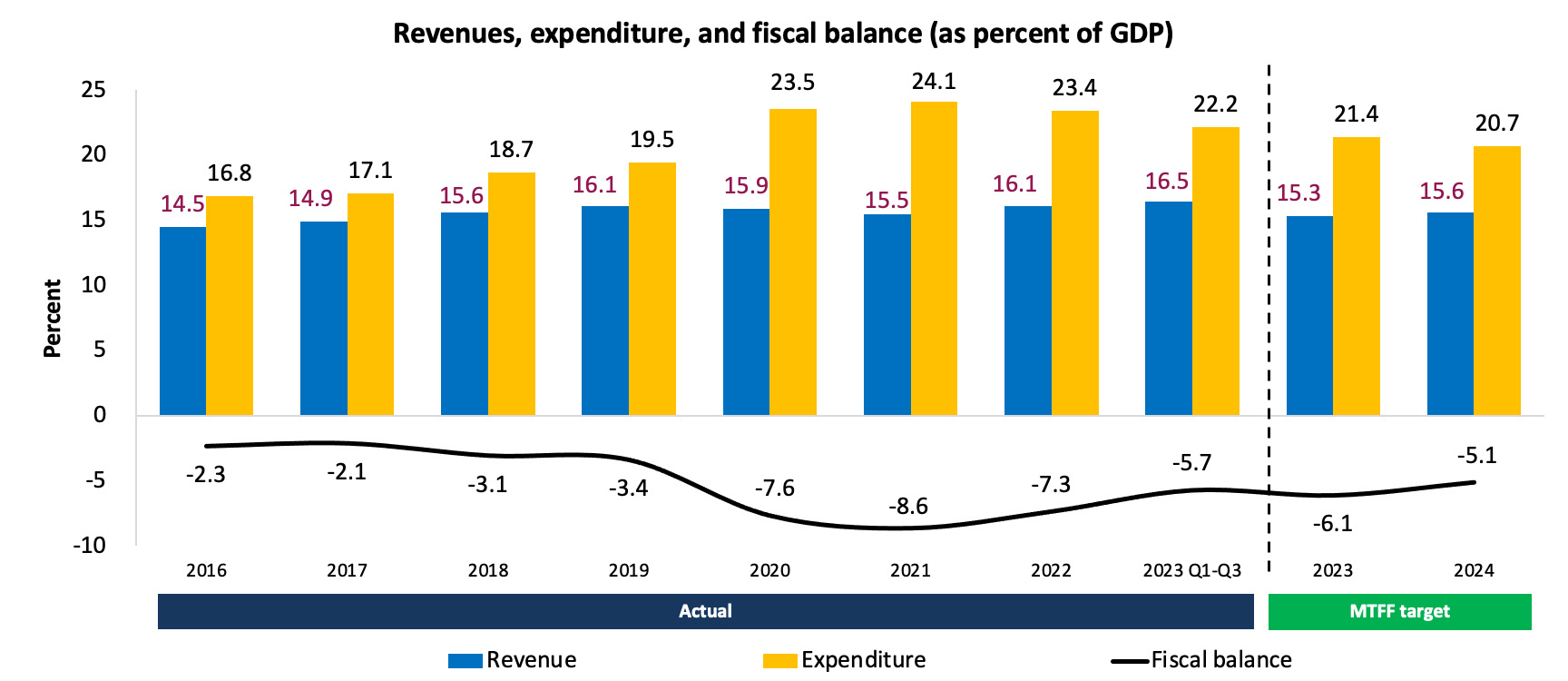
Data sources: Bureau of the Treasury, MTFF, and PSA
Figure 7. National Government Debt (as percent of GDP)
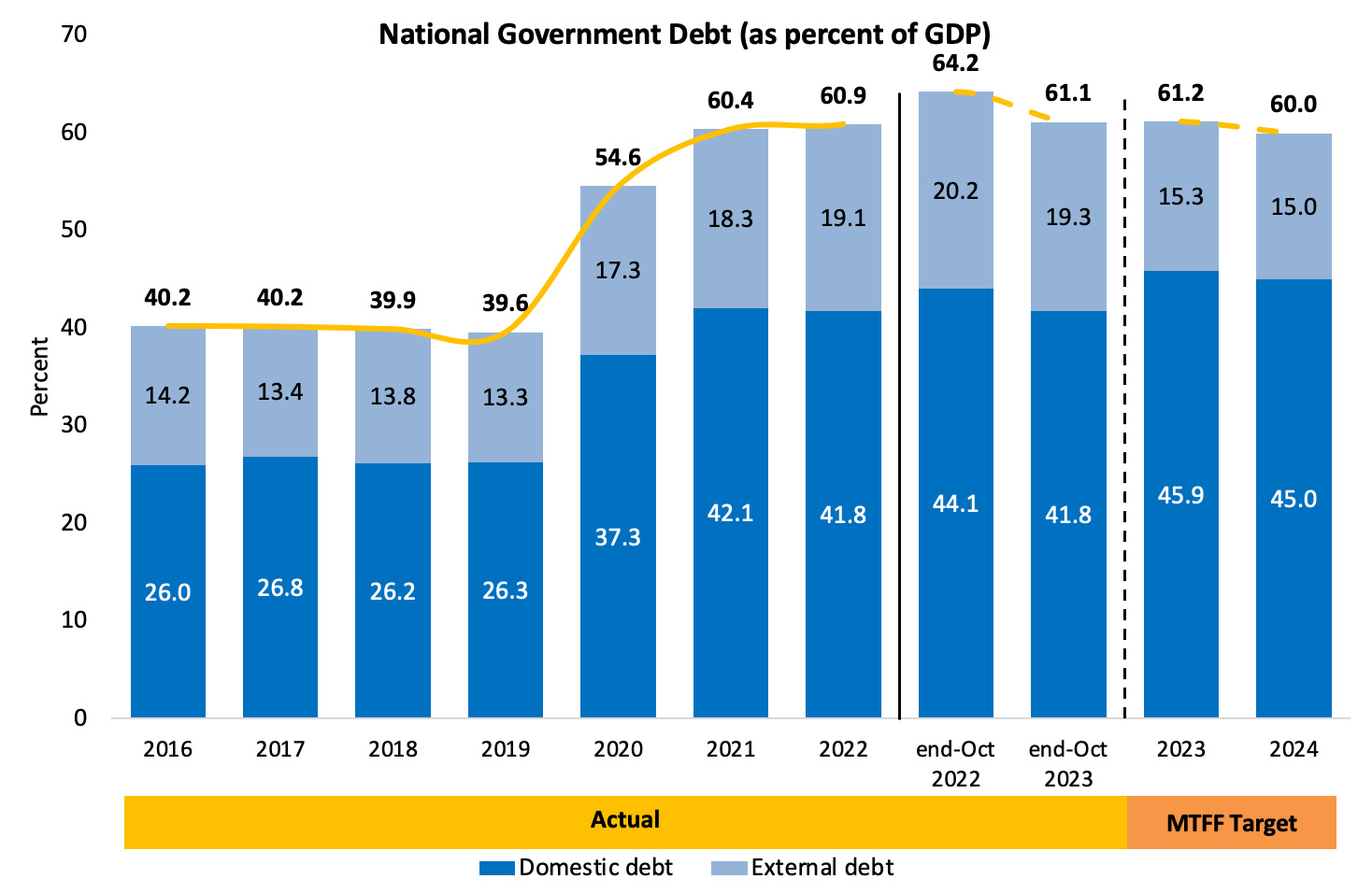 Data sources: Bureau of the Treasury and MTFF
Data sources: Bureau of the Treasury and MTFF
The IMF and the ASEAN+3 Macroeconomic Research Office (AMRO) acknowledged the MTFF as a firm commitment of the Marcos, Jr. administration to a gradual fiscal consolidation path aimed at igniting sustained growth while bolstering fiscal stability and restoring fiscal space, and stands poised for a dynamic economic future.
Moreover, the national budget was approved on time for the second consecutive year, showing the very strong relationship between the Executive Department and Congress.
Monetary policy and financial sector are performing well. The appropriate monetary policy succeeded in easing the entrenched inflationary pressures. The BSP’s key policy rate was increased by a cumulative 100 basis points this year to 6.5 percent to help anchor inflation expectations. The banking sector also remains a source of strength with capital adequacy ratios[1] (CARs) above regulatory requirements of the BSP and BSP-supervised institutions (BSIs), and non-performing loan[2] (NPL) levels manageable. This suggests that banks are well-positioned to support the economy in the coming months.
Digitalization is on the march. The use of digital payments in financial transactions continues to deepen which could account for more than half of all financial transactions as close to 70 percent of adult Filipinos now have financial accounts. The pervasive use of QR Ph, launched by the BSP, in public markets and local transport systems increase economic activities at the local level and support financial inclusion. In Alaminos City for example, approximately 700 market vendors and over 3,600 tricycle drivers have actively participated in the Paleng-QR Ph Plus program, according to the BSP. Furthermore, the BSP is also planning to expand the program to include cities such as Baguio, Davao, Tagbilaran, Naga, Lapu-Lapu, Pasig, Bacolod, Victorias, Mandaue, Ozamiz, Cotabato, and the towns of Camiling in Tarlac and Carmona in Cavite.
The external sector is improving. The Balance of Payments (BOP) position is forecasted by the BSP to be at a surplus this year at 0.2 percent from a deficit of 1.8 percent in 2022, as the latest current account forecast remain broadly unchanged while the financial account has been revised upward, a testament to the nation's economic resilience.
[1] As of end-March 2023, the capital adequacy ratio of the Philippine Banking System was at 16.0 percent, comfortably exceeding the BSP's 10 percent and the Bank for International Settlements' 8 percent minimum thresholds.
[2] As of end-October 2023, the Philippine banking sector's non-performing loans (NPL) ratio was 3.44 percent, backed by a robust coverage ratio of 102.59 percent. In October 2023, the liquid assets to deposits ratio stood at 51.75 percent.
The Philippine peso continues to appreciate, settling at 55.57 per US dollar on December 29, 2023. With this, the peso-dollar exchange rate for 2023 averaged at PHP 55.57/USD, within the government’s exchange rate assumption at PHP 55.50 to 60.00/USD.
OF remittances, export revenues from Business Process Outsourcing (BPO) firms, tourism receipts, and foreign direct investments (FDI)[1] will remain as stable sources of foreign exchange.[2] In the latest BSP external outlook for 2023, BPO revenues are expected to grow by 8.0 percent while travel receipts will expand by 110 percent. OF remittances will have a stable growth of 3.0 percent this year.[3]
The current gross international reserve (GIR) level[4] remains well above the IMF’s Assessing Reserve Adequacy metric at 1.9 index points in 2023, remarkably higher than China’s 0.7 as well as Malaysia and Indonesia both at 1.1. This will also be supported by the rising price of gold.[5]
Moreover, the Philippines’ low external debt-to-GDP ratio also reflects the country’s robust external fundamentals. Among the ASEAN-5 countries, the Philippines prides itself on having the lowest external debt-to-GDP ratio. As of end-Q3 2023, the Philippines’ external debt-to-GDP ratio was only 28.1 percent, lower compared to Indonesia’s 28.9 percent and Malaysia’s 69.0 percent for the same period as well as Thailand’s 38.4 percent as of Q2 2023[6] (Figure 8).
Figure 8. External Debt of ASEAN Countries (as percent of GDP)
Data source: BSP
[1] In the first nine months of 2023, net FDI inflows reached USD 5.9 billion. However, this is lower by 15.9 percent from the USD 7.0 billion net FDI inflows reported from the same period last year. The BSP projects net FDI inflows to reach 8 percent in 2023 and 10 percent in 2024.
[2] On a YTD basis, cash remittances from OFs coursed through banks in the first 10 months of 2023 amounted to about USD 27.5 billion higher by 2.8 percent than the same period last year. Meanwhile, total estimated BPO export revenues, consisting of computer and other business services, amounted to USD 21.3 billion for the first three quarters of 2023, higher by 7.6 percent than the USD 19.8 billion during the same period in 2022. Moreover, travel receipts increased by 217.9 percent to USD 6.6 billion from January to September 2023, bolstered by the improving tourism condition in the country.
[3] Emerging as of Q4 2023 released by the BSP on December 15, 2023.
[4] The increase in the GIR level to USD 102.7 billion as of November 2023 represents a more than adequate external liquidity buffer equivalent to 7.6 months’ worth of imports of goods and payments of services and primary income.
[5] Futures gold prices are expected to increase until October 2025 to USD 2,228.2 per troy ounce (oz t) from USD 2,058.2/oz t in December 2023 based on Bloomberg data access on December 27, 2023.
[6] As of end-Q2 2023, latest data available.
Robust Economic Growth will continue in 2024
While multilateral organizations project a slower global outlook for 2024 at 2.9 percent, the Philippine economy is expected to improve, reinforcing its status as one of the fastest-growing economies in the region.
The DBCC assumes a growth rate of 6.5 to 7.5 percent for the country in 2024. Amid the ongoing strong El Niño and geopolitical and trade tensions, the country’s growth is expected to be driven by strong private consumption, supported by the expected return of inflation within the target range, falling oil prices, robust public spending, greater investments lured by the country’s sound macroeconomic fundamentals, investment-grade credit rating, and the implementation of structural reforms, and increased demand for Philippine exports as supply chain bottlenecks ease. Economic prospects will be even better with the alignment of policies between fiscal and monetary authorities, proactive monitoring and speedy action on sources of inflation, and closer coordination of all public sector entities – national government, local government units (LGUs), the corporate sector, and government financial institutions – in moving programs and projects consistent with the Philippine Development Plan 2023-2028 and in easing the cost of doing business in the country. With these, the Philippines can confidently march towards a robust economic future, with a path that constitutes a confluence of favorable factors.
First, the recognition of multilateral organizations of the Marcos, Jr. administration’s swift policy actions through the MTFF in response to the challenges arising from the global shocks shows a vote of confidence in the country’s policy environment. Navigating a post-pandemic world, the Philippines charts a steady course toward fiscal stability as we remain on track to achieving our fiscal targets. The government aims to achieve its MTFF targets for 2024, which further reduces the NG fiscal deficit-to-GDP ratio to 5.1 percent and the NG debt-to-GDP ratio to 60.0 percent while maintaining the share of infrastructure spending at 5.0-6.0 percent of GDP. With the consolidated efforts of the DBCC, the Philippines readies itself to fine-tune its fiscal compass next year.
Second, for two consecutive years, the national budget was approved on time – a difficult feat under global uncertainties. This indicates the very strong relationship between the Executive Department and Congress. The timely approval of the 2024 national budget will ensure quick and efficient government spending for the coming year. As early as August this year, following the release of the National Expenditure Program, the EDG has encouraged both government line agencies and government-owned and controlled corporations (GOCCs) to conduct early procurement activities to ensure that underspending will not be a drag again to economic growth next year. Moreover, the government will be spending more in the early part of 2024 to help boost economic activity for the rest of the year and break the cycle of rushing its spending towards year-end.
Third, BSP’s efforts on monetary policy actions and the direct strategies being implemented by the administration through the IAC-IMO to ease inflationary pressures appear to be bearing fruit, with the inflation rate returning to the target range of 2.0 to 4.0 percent in 2024 until 2028. Along with the appropriate monetary policy actions from the BSP, efforts are being intensified toward addressing high inflationary pressures in order to sustain deceleration in inflation heading into 2024. Keeping the inflation rate within manageable levels to protect the Filipino people’s purchasing power and maintaining macroeconomic stability shall remain the government’s top priority.
Fourth, the country’s investor-grade credit ratings are a vote of confidence in the economy. In November, both S&P Global and Fitch Ratings affirmed the Philippines’ BBB+ and triple-B ratings with Stable outlook, respectively. In August 2023, Rating and Investment Information, Inc. (R&I), a Japanese credit rating agency, affirmed the country’s triple-B plus rating and revised its outlook from stable to positive. Credit rating agencies and market analysts remain confident in the country’s macroeconomic fundamentals due to the sustained economic recovery, strong external position, improving fiscal position with declining debt, sound banking system, and stable political environment.
Fifth, our policy environment remains primed for heightened investment activities in the country with the enactment of the Public-Private Partnership (PPP) Code and the Maharlika Investment Fund (MIF). The PPP Code optimizes public-private collaborations and helps ensure the realization of high-quality infrastructure and services in the country to reach the government’s target infrastructure spending of 5 to 6 percent.
The MIF is the Philippines’ first-ever sovereign wealth fund that will optimize national funds by generating returns to support the infrastructure development agenda of the government, create jobs, promote investments, strengthen connectivity, achieve energy, water and food security and support the government’s poverty reduction efforts by sustaining the economy’s high growth trajectory and ensuring sustainable development, with the end in view of promoting efficient intergenerational management of wealth. President Ferdinand Marcos Jr. has appointed Rafael D. Consing Jr. as President and Chief Executive Officer (CEO) of the Maharlika Investment Corporation (MIC) and named four directors, who would govern the country’s first-ever sovereign wealth fund.
The economic team continues to see possible improvements in the FDI prospects for the country along with game-changing structural reforms such as the Corporate Recovery and Tax Incentives for Enterprises (CREATE) Act and amendments to the Public Service Act, Retail Trade Liberalization Act, Foreign Investments Act, and the revised implementing rules and regulations of the Renewable Energy Act.
The economic managers are also conducting weekly meetings to help ensure that these crucial structural reforms are properly implemented. During the latest weekly economic managers’ meeting held on December 20, 2023, they tackled the Ease of Doing Business and Efficient Government Service Delivery Act of 2018 to improve the investment environment in the country. The Anti-Red Tape Authority (ARTA) was one of the resource agencies invited to report on the status of the measure, as it is the main implementing agency and overseer of the national policy on red tape. ARTA is improving and optimizing the regulation in sectors with significant impact on the economy, with the priority sectors being (i) Telecommunications and Connectivity, (ii) Energy, (iii) Logistics, (iv) Health, Food, and Pharmaceuticals, and (v) Infrastructure. ARTA is also actively monitoring and promoting government agencies to leverage technology to efficiently deliver services, citing digital solutions such as the eGov Super App, the Philippine Business Hub, the Philippine Business Databank, the Electronic Business One Stop Shop, and Tradenet. Furthermore, emphasis was placed on recognizing and implementing successful strategies and approaches throughout the government. ARTA has outlined specific measures—such as the Citizen’s Charter, Report Card Survey, Zero Backlog Policy, Committee on Anti-Red Tape, and Anti-Red Tape Electronic Management Information System—to ensure smoother processes and compliance across government entities.
Sixth, the country’s external position remains strong to withstand external vulnerabilities. The BOP position is forecasted by the BSP to remain at a surplus at 0.1 percent in 2024. The Philippine peso will continue to be supported by structural inflows as BPO revenues grow by 7.0 percent, travel receipts expand by 50 percent, and OF remittances maintain growth of 3.0 percent based on the latest BSP outlook.[1]
Seventh, the ratification of the Regional Comprehensive Economic Partnership (RCEP) and other Free Trade Agreements (FTAs), such as the Philippines and South Korea FTA, will facilitate trade diversification and expand the country’s market access for goods and services, attract more investments, and create more and better jobs. The Philippines’ participation in the Indo-Pacific Economic Framework for Prosperity (IPEF) will also help position the country as a reliable global partner and a prime location for businesses that seek to diversify and expand their supply chains for manufactured goods. The government will continue to pursue the finalization of other trade agreements and ensure that negotiations under the ASEAN with Australia and New Zealand, China and other ASEAN-led FTAs will advance the country’s position in the region.
Eighth, we expect the passage of key tax reforms which are already in the advanced stages in Congress this year to help ensure sufficient government financing of the 2024 budget. The Department of Finance (DOF) will continue working with Congress in pushing for Package 3 or the Real Property Valuation and Assessment Reform (RPVAR), value-added tax (VAT) on non-resident digital service providers (DSPs), excise tax on single-use plastics, and motor vehicle road user’s tax, among others. These reforms will help finance next year’s national budget and attain the 5.1 percent deficit-to-GDP target for 2024. The Marcos, Jr. administration has also accomplished the passage of the Automatic Income Classification of LGUs Act this year.
Ninth, we will harness LGUs as engines of economic growth. To ensure a smoother and more effective transition, the Committee on Devolution has been evaluating which functions and services should be retained with the National Government and those that should be devolved to LGUs based on their capacity. This lays a stronger foundation for a well-ordered devolution process.
To tackle the remaining economic agenda items, concerted efforts are needed. With this, we require significant contributions from the NG, LGUs, and GOCCs. By pursuing close coordination among these units, we can unlock our full potential and achieve lasting economic prosperity.
In navigating global uncertainties and the remnants of the adversities during the pandemic, the country’s sound macroeconomic policies, strong macroeconomic fundamentals and commitment to structural reforms have proven the government’s steadfast dedication to working towards robust economic growth for the Philippines. With the improvement in the country’s poverty incidence in the first semester of 2023[2] amid numerous economic challenges, one can be assured that the government will put all its efforts into working with various sectors to help ensure a continuous improvement in the lives of every Filipino.
[1] Emerging as of Q4 2023 released by the BSP on December 15, 2023.
[2] According to the PSA, poverty incidence among families declined to 16.4 percent in the first semester of 2023 from 18.0 percent in the same period of 2021, equivalent to 230,000 households escaping poverty. In terms of population, poverty incidence decreased from 23.7 percent to 22.4 percent, or 895,260 less poor Filipinos.